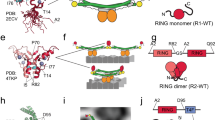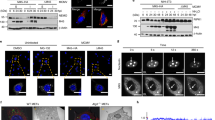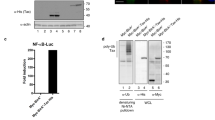Abstract
While the process of homo-oligomer formation and disassembly into subunits represents a common strategy to regulate protein activity, reports of proteins in which the subunit and homo-oligomer perform independent functions are scarce. Tumorigenesis induced by the adenovirus E4-ORF1 oncoprotein depends on its binding to a select group of cellular PDZ proteins, including MUPP1, MAGI-1, ZO-2 and Dlg1. We report here that in cells E4-ORF1 exists as both a monomer and trimer and that monomers specifically bind and sequester MUPP1, MAGI-1 and ZO-2 within insoluble complexes whereas trimers specifically bind Dlg1 and promote its translocation to the plasma membrane. This work exposes a novel strategy wherein the oligomerization state of a protein not only determines the capacity to bind separate related targets but also couples the interactions to different functional consequences.
This is a preview of subscription content, access via your institution
Access options
Subscribe to this journal
Receive 50 print issues and online access
$259.00 per year
only $5.18 per issue
Buy this article
- Purchase on Springer Link
- Instant access to full article PDF
Prices may be subject to local taxes which are calculated during checkout





Similar content being viewed by others
References
Bhakdi S, Fussle R, Tranum-Jensen J . (1981). Staphylococcal alpha-toxin: oligomerization of hydrophilic monomers to form amphiphilic hexamers induced through contact with deoxycholate detergent micelles. Proc Natl Acad Sci USA 78: 5475–5479.
Chung SH, Frese KK, Weiss RS, Prasad BV, Javier RT . (2007). A new crucial protein-interaction element that targets the adenovirus E4-ORF1 oncoprotein to membrane vesicles. J Virol 81: 4787–4797.
DiMaio D, Mattoon D . (2001). Mechanisms of cell transformation by papillomavirus E5 proteins. Oncogene 20: 7866–7873.
Forti S, Menestrina G . (1989). Staphylococcal alpha-toxin increases the permeability of lipid vesicles by cholesterol- and pH-dependent assembly of oligomeric channels. Eur J Biochem 181: 767–773.
Frese KK, Latorre IJ, Chung SH, Caruana G, Bernstein A, Jones SN et al. (2006). Oncogenic function for the Dlg1 mammalian homolog of the Drosophila discs-large tumor suppressor. EMBO J 25: 1406–1417.
Glaunsinger BA, Lee SS, Thomas M, Banks L, Javier R . (2000). Interactions of the PDZ-protein MAGI-1 with adenovirus E4-ORF1 and high-risk papillomavirus E6 oncoproteins. Oncogene 19: 5270–5280.
Glaunsinger BA, Weiss RS, Lee SS, Javier R . (2001). Link of the unique oncogenic properties of adenovirus type 9 E4-ORF1 to a select interaction with the candidate tumor suppressor protein ZO-2. EMBO J 20: 5578–5586.
Grootjans JJ, Reekmans G, Ceulemans H, David G . (2000). Syntenin–syndecan binding requires syndecan–synteny and the co-operation of both PDZ domains of syntenin. J Biol Chem 275: 19933–19941.
Hirata A, Higuchi M, Niinuma A, Ohashi M, Fukushi M, Oie M et al. (2004). PDZ domain-binding motif of human T-cell leukemia virus type 1 Tax oncoprotein augments the transforming activity in a rat fibroblast cell line. Virology 318: 327–336.
Holloway JM, Szeto DP, Scully KM, Glass CK, Rosenfeld MG . (1995). Pit-1 binding to specific DNA sites as a monomer or dimer determines gene-specific use of a tyrosine-dependent synergy domain. Genes Dev 9: 1992–2006.
Humbert PO, Dow LE, Russell SM . (2006). The Scribble and Par complexes in polarity and migration: friends or foes? Trends Cell Biol 16: 622–630.
Kiyono T, Hiraiwa A, Fujita M, Hayashi Y, Akiyama T, Ishibashi M . (1997). Binding of high-risk human papillomavirus E6 oncoproteins to the human homologue of the Drosophila discs large tumor suppressor protein. Proc Natl Acad Sci USA 94: 11612–11616.
Latorre IJ, Roh MH, Frese KK, Weiss RS, Margolis B, Javier RT . (2005). Viral oncoprotein-induced mislocalization of select PDZ proteins disrupts tight junctions and causes polarity defects in epithelial cells. J Cell Sci 118: 4283–4293.
Lee SS, Glaunsinger B, Mantovani F, Banks L, Javier RT . (2000). Multi-PDZ domain protein MUPP1 is a cellular target for both adenovirus E4-ORF1 and high-risk papillomavirus type 18 E6 oncoproteins. J Virol 74: 9680–9693.
Lee SS, Weiss RS, Javier RT . (1997). Binding of human virus oncoproteins to hDlg/SAP97, a mammalian homolog of the Drosophila discs large tumor suppressor protein. Proc Natl Acad Sci USA 94: 6670–6675.
Long JF, Tochio H, Wang P, Fan JS, Sala C, Niethammer M et al. (2003). Supramodular structure and synergistic target binding of the N-terminal tandem PDZ domains of PSD-95. J Mol Biol 327: 203–214.
Miralles F, Posern G, Zaromytidou AI, Treisman R . (2003). Actin dynamics control SRF activity by regulation of its coactivator MAL. Cell 113: 329–342.
Mol CD, Harris JM, McIntosh EM, Tainer JA . (1996). Human dUTP pyrophosphatase: uracil recognition by a beta hairpin and active sites formed by three separate subunits. Structure 4: 1077–1092.
Raffy S, Teissie J . (1999). Control of lipid membrane stability by cholesterol content. Biophys J 76: 2072–2080.
Ramachandran R, Tweten RK, Johnson AE . (2004). Membrane-dependent conformational changes initiate cholesterol-dependent cytolysin oligomerization and intersubunit beta-strand alignment. Nat Struct Mol Biol 11: 697–705.
Shin K, Straight S, Margolis B . (2005). PATJ regulates tight junction formation and polarity in mammalian epithelial cells. J Cell Biol 168: 705–711.
Soneoka Y, Cannon PM, Ramsdale EE, Griffiths JC, Romano G, Kingsman SM et al. (1995). A transient three-plasmid expression system for the production of high titer retroviral vectors. Nucleic Acids Res 23: 628–633.
Umeda K, Ikenouchi J, Katahira-Tayama S, Furuse K, Sasaki H, Nakayama M et al. (2006). ZO-1 and ZO-2 independently determine where Claudins are polymerized in tight-junction strand formation. Cell 126: 741–754.
Weiss RS, Lee SS, Prasad BV, Javier RT . (1997). Human adenovirus early region 4 open reading frame 1 genes encode growth-transforming proteins that may be distantly related to dUTP pyrophosphatase enzymes. J Virol 71: 1857–1870.
Zhao K, Wang W, Rando OJ, Xue Y, Swiderek K, Kuo A et al. (1998). Rapid and phosphoinositol-dependent binding of the SWI/SNF-like BAF complex to chromatin after T lymphocyte receptor signaling. Cell 95: 625–636.
Acknowledgements
We thank Andy Rice and Chris Herrmann for use of their FPLC system and Richard Sutton for retroviral vector plasmids. RSW and KKF were supported by predoctoral fellowships from the US. Army (Breast Cancer Training Grant DAMD17-94 J4204) and the National Cancer Institute (Viral Oncology Training Grant T32 CA09197). This research was funded by Public Health Service Grants CA58541 (RTJ) and AI36040 (BVVP).
Author information
Authors and Affiliations
Corresponding author
Additional information
Supplementary Information accompanies the paper on the Oncogene website (http://www.nature.com/onc).
Supplementary information
Rights and permissions
About this article
Cite this article
Chung, SH., Weiss, R., Frese, K. et al. Functionally distinct monomers and trimers produced by a viral oncoprotein. Oncogene 27, 1412–1420 (2008). https://doi.org/10.1038/sj.onc.1210784
Received:
Revised:
Accepted:
Published:
Issue Date:
DOI: https://doi.org/10.1038/sj.onc.1210784
Keywords
This article is cited by
-
Characterization of the adipogenic protein E4orf1 from adenovirus 36 through an in silico approach
Journal of Molecular Modeling (2020)
-
Cell polarity proteins: common targets for tumorigenic human viruses
Oncogene (2008)



